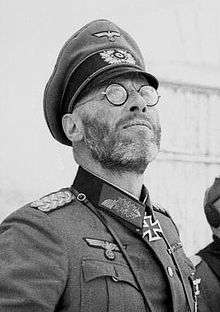Theodor Scherer
Theodor Scherer (17 September 1889 – 17 May 1951) was a German general and divisional commander in the Wehrmacht during World War II.
Theodor Scherer | |
|---|---|
 | |
| Born | 17 September 1889 Höchstädt an der Donau |
| Died | 17 May 1951 (aged 61) Ludwigsburg |
| Allegiance | |
| Service/ | Army |
| Years of service | 1909–20 1935–45 |
| Rank | Generalleutnant |
| Commands held | 281st Security Division |
| Battles/wars | World War I
World War II |
| Awards | Knight's Cross of the Iron Cross with Oak Leaves |
In October 1941, Scherer took command of 281st Security Division, stationed in Kholm, in the occupied Soviet Union. (The security divisions were not frontline combat formations, but were posted to the rear area and engaged in eliminating any form of resistance, real or imagined, including partisans, communists, Red Army stragglers, Jews and Roma.[1]) In January 1942, the division, along with other Wehrmacht and police units, was encircled at Kholm, and was not relieved until 5 May 1942. For his defense of the Kholm Pocket, Scherer was decorated with the Knight's Cross of the Iron Cross on 20 February 1942.
Scherer was subsequently appointed commander of the 34th and then the 83rd Infantry Division. The division was deployed in Velikije Luki on the left flank of Army Group Center, when it was encircled by the Soviet 3rd Shock Army in November 1942 and subsequently destroyed by mid-January 1943. Scherer then served in a staff role in the 4th Panzer Army and at the end of the war was in charge of the defence of the Schwarzen Elster river, near the Elbe. He was killed in a car accident at Ludwigsburg in May 1951.
Awards and decorations
- Iron Cross (1914) 2nd Class (26 August 1914) & 1st Class (17 January 1920)[2]
- Clasp to the Iron Cross (1939) 2nd Class & 1st Class (20 June 1940)[2]
- Knight's Cross of the Iron Cross with Oak Leaves
- Knight's Cross on 20 February 1942 as Generalmajor and commander of the 281. Sicherungs-Division[3]
- Oak Leaves on 5 May 1942 as Generalmajor and commander of the 281. Sicherungs-Division[4]
- Cholm Shield on 31 October 1942[5]
References
Citations
- Lower, Wendy (2005):Nazi Empire-Building and the Holocaust in Ukraine
- Thomas 1998, p. 253.
- Fellgiebel 2000, p. 305.
- Fellgiebel 2000, p. 53.
- Traces of War Scherer, Theodor
Bibliography
- Fellgiebel, Walther-Peer (2000) [1986]. Die Träger des Ritterkreuzes des Eisernen Kreuzes 1939–1945 — Die Inhaber der höchsten Auszeichnung des Zweiten Weltkrieges aller Wehrmachtteile [The Bearers of the Knight's Cross of the Iron Cross 1939–1945 — The Owners of the Highest Award of the Second World War of all Wehrmacht Branches] (in German). Friedberg, Germany: Podzun-Pallas. ISBN 978-3-7909-0284-6.
- Thomas, Franz (1998). Die Eichenlaubträger 1939–1945 Band 2: L–Z [The Oak Leaves Bearers 1939–1945 Volume 2: L–Z] (in German). Osnabrück, Germany: Biblio-Verlag. ISBN 978-3-7648-2300-9.
| Military offices | ||
|---|---|---|
| Preceded by Generalleutnant Friedrich Fürst |
Commander of 34. Infanterie-Division 5 September 1942 – 2 November 1942 |
Succeeded by General der Infanterie Friedrich Hochbaum |
| Preceded by Generalmajor Adolf Sinzinger |
Commander of 83. Infanterie-Division 2 November 1942 – 1 March 1944 |
Succeeded by Generalmajor Wilhelm Heun |